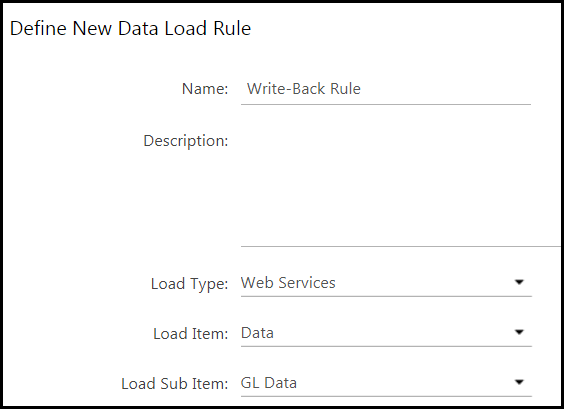- 4 Minutes to read
- Print
- DarkLight
- PDF
Using Write Back
- 4 Minutes to read
- Print
- DarkLight
- PDF
To enable write back capabilities from Dynamic Planning back into Planful Structured Planning, Consolidation, and Reporting applications, perform the following:
Set up a Data Load Rule in Planful Structured Planning, Consolidation, and Reporting applications to load the data.
Use this Data Load Rule in Planful Structured Planning, Consolidation, and Reporting applications in conjunction with a Map in Dynamic Planning to facilitate the movement of data.
Specify settings required to enable Web Services in both Planful Structured Planning, Consolidation, and Reporting applications and Dynamic Planning.
Important
You can use one Calculation to writeback data from multiple models to Structured Planning, Consolidation, and Reporting applications, however, one map per model must be provided in the Calculation. Also one data load rule per map must be created in Structured Planning, Consolidation, and Reporting applications.
Now that you have copied metadata and data from Structured Planning, Consolidation, and Reporting applications to the Dynamic Planning application, you have the option to use your new model read-only or read-write. There is not a live link between Structured Planning, Consolidation, and Reporting applications and the Target model, so any changes you make in the Dynamic Planning model remain only in that model unless you explicitly write them back to Structured Planning, Consolidation, and Reporting applications. Power user access is required for these steps.
To set up your environment for write-back:
Structured Planning, Consolidation, and Reporting applications: set up access to the Web Service
Structured Planning, Consolidation, and Reporting applications: set up a Data Load Rule that will accept incoming data from Dynamic Planning
Dynamic Planning: set up the URL address pointing back to Structured Planning, Consolidation, and Reporting applications
Dynamic Planning: set up a Data Map to map dimensions and members back to Structured Planning, Consolidation, and Reporting applications
Dynamic Planning: set up a Calculation to run the Data Map
Structured Planning, Consolidation, and Reporting applications: run a report to validate that data has been changed
With this setup, you will be able to run the Calculation whenever you want to write data back to Structured Planning, Consolidation, and Reporting applications.
Structured Planning, Consolidation, and Reporting Applications: Configure Access to Web Services
In Structured Planning, Consolidation, and Reporting applications, login and select the Application that will receive data updates from Dynamic Planning.
In Practice: Maintenance > Configuration Tasks
Select Web Service Access.
On the Web Service Access page:
Under API, select Enable.
Look at the State Free Authentication URL and copy/paste it into Notepad or another document for safekeeping.
In the Available Users box, specify the username that will have access to both the Structured Planning, Consolidation, and Reporting applications and the Dynamic Planning application. Then use the right arrow to move the username into the Email User(s) list so that you will receive an email at the conclusion of each write-back.
.png)
Click Save and Complete.
Structured Planning, Consolidation, and Reporting Applications: Configure a Data Load Rule to Accept Data from Dynamic Planning
Be sure that you are still logged in. Now you will create a data load rule that will accept incoming data from Dynamic Planning.
In Practice: Maintenance > Data Load Rules
Click New Data Load Rule. Then specify:
Rule name
Load Type: Web Services
Load Item: Data
Load Sub Item: GL Data

Then click Next or Select Sample Input File.
Specify the following items:
Row Containing Header: 0
Number of Rows to Skip: 0
Number of Source Fields: the number of segments in your Structured Planning, Consolidation, or Reporting applications (not your model) plus three (Fiscal Year, Fiscal Month, and Amount)
Do not change the other fields on this page.
.png)
Click Next or Define Overall Rule Settings.
Specify the following items:
Reporting: Common Currency
Credit/Debit: No for negative numbers, Yes for positive numbers
Data Type: MTD or YTD (whichever you chose in your initial download Map)
Calculate Trial Balance: No
Currency Conversion: either Yes or No
Scenario Type: All
Scenario: select the Scenario containing the changes that are to be written back
Frequency: Month
Time Mapping: Down Rows
Automatic Cube Refresh: Yes
Roll Annual Balances: No
Here is an example:.png)
Do not change the “Defaults” and “Clear Data Combination” sections.
Click Next or Manipulate Input File.
No changes on this page.
Click Next or Define Data Mappings.
From the list boxes, select the segments that correspond to the dimensions in your Map, in alphabetical order. You do not need to map Scenario, Reporting, Time, or Measures. The last 3 columns must be Fiscal Year, Fiscal Month, and Amount.
Click Next or Load Data.
Select the Scenario you chose in your Map or that data has been changed in.
Click Finish.
Note:
The Data Load Rule that you create will remember the data items it modifies when you use it for write-back. A best practice is to use the same Data Load Rule for the write-back procedures from your model consistently. For example, if users are writing back 2023 Budget Data for a certain department and certain accounts, create and use one Data Load Rule for that data grouping and use a specific name, such as ‘2023BudgetSalesTravel.’ Then every time data is written back, it will overwrite data that was there before. If you use more than one Data Load Rule for writing the same data items, the data will aggregate instead of overwrite.

.png)

.png)
.png)